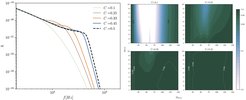Towards identifying exotic compact object binaries in gravitational-wave data
A Hannover-Cardiff research team has developed a new, generic, compactness-based framework for distinguishing between signals from black hole mergers and those from exotic compact objects.
Gravitational-wave astronomy has discovered numerous mergers of black holes and neutron stars. It may one day also find mergers of a new, proposed class of compact objects known as exotic compact objects (ECOs). In a recent study, researchers from the Max Planck Institute for Gravitational Physics (Albert Einstein Institute) in Hannover and Cardiff University introduced a new phenomenological approach to identify gravitational waves from ECO mergers. They modified a standard black hole merger waveform model by adding a single, physically motivated property: compactness. This approach relies on a generic ECO signature, which is that less compact objects merge at lower frequencies than black holes of the same mass. The researchers studied the parameter space in which current searches would miss or misidentify ECO binaries under the assumptions about the signature. They demonstrated that the compactness can be reliably recovered in simulated and real data. This tool can efficiently guide future searches for ECOs and new fundamental physics in gravitational-wave signals and help prioritize simulation efforts to make new and exotic discoveries.
Paper abstract
Gravitational wave (GW) astronomy has been hailed as a gateway to discovering unexpected phenomena in the universe. Over the last decade there have been close to one hundred GW observations of compact-binary mergers. While these signals are largely consistent with mergers of binary black holes, binary neutron stars, or black hole-neutron star systems, some events suggest the intriguing possibility of binaries involving exotic compact objects (ECOs). Identifying and characterising an ECO merger would require accurate ECO waveform models. Using large numbers of numerical relativity simulations to develop customised models for ECO mergers akin to those used for binary black holes, would be not only computationally expensive but also challenging due to the limited understanding of the underlying physics. Alternatively, key physical imprints of the ECO on the inspiral or merger could in principle be incorporated phenomenologically into waveform models, sufficient to quantify generic properties. In this work we present a first application of this idea to assess the detectability and distinguishability of ECO mergers, and we propose a phenomenological approach that can iteratively incorporate features of ECO mergers, laying the groundwork for an effective exotic compact object identifier in compact binary coalescences. We demonstrate that within this framework the compactness of the objects in GW150914 are consistent with that of black holes. The efficacy of the identifier can be refined by adding information from numerical relativity simulations involving fundamental fields. Conversely, such an identifier framework can help focus future numerical relativity and modeling efforts for exotic objects.













